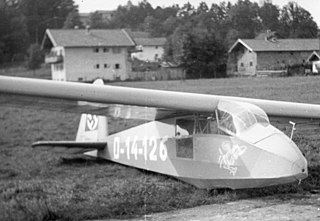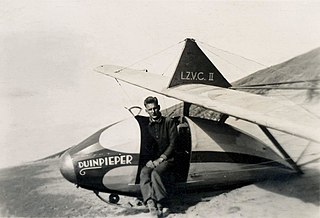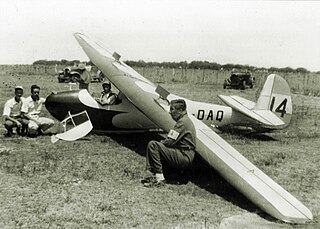Contrary to the methods used by the Reich Air Ministry (RLM) for the allocation of aircraft designations, the designers and manufacturers of sailplanes and gliders in Germany enjoyed the freedom of choosing their own designations for their products up until 1945.
Thus a bird name like Habicht could be used, or a number combined with two or more letters, stemming from the designer's or factory's name, such as DFS, RRG or Göppingen. The RLM only assigned them for every design a separate number, which obviously served the same purposes as that used with aircraft, namely to provide a common basis for an exchange of drawings in the event of an intended production under license by other firms or by clubs, or even single persons and to secure the provision of spare parts. A rigid system of rules for the form and order of drawings was applied.

The Deutsche Forschungsanstalt für Segelflug, or DFS, was formed in 1933 to centralise all gliding activity in Germany, under the directorship of Professor Georgii. It was formed by the nationalisation of the Rhön-Rossitten Gesellschaft (RRG) at Darmstadt.
The Rhön-Rossitten Gesellschaft (RRG) or Rhön-Rossitten Society was a German gliding organization, the first one in the world that was officially recognised. The Rhön-Rossitten Gesellschaft was mainly responsible for establishing gliding as a sport, not only in Germany but eventually throughout the world.
Schempp-Hirth Flugzeugbau GmbH is a glider manufacturer based in Kirchheim unter Teck, Germany.
Whereas RLM aircraft designations were prefixed by the number 8, glider references began with "108-", for example 108-53 referred to the DFS Habicht.

The DFS Habicht is an unlimited aerobatic sailplane that was designed in 1936 by Hans Jacobs with support provided by the Deutsche Forschungsanstalt für Segelflug. Four planes were made available for the Olympic Games of 1936, where the maneuvers of the Habicht over and literally inside the Olympic stadium enthralled spectators.
In a relaxation of the regulations regarding allocation of aircraft designations, the designers and manufacturers of sailplanes and gliders in Germany enjoyed the freedom of choosing their own designations for their products up until 1945, but some of the more common aircraft were issued RLM designations in the 108 series.
- 108-10
- Schneider Grunau 9 - primary glider (1929)
- 108-11
- RRG Zögling 33 - primary glider (1933)
- 108-14
- DFS Schulgleiter SG.38 - standard basic gliding trainer (1938)
- 108-15
- RRG Zögling 12m - primary glider (1934)
- 108-16
- Weber EW-2 - four-seat high-performance sailplane
- 108-21
- Hirth Hi 21 - two-seat sailplane
- 108-22
- Hirth Hi-20 MoSe - (for Motorsegler = motor glider); motorized glider
- 108-29
- Fliege IIa - primary glider (1935)
- 108-30
- DFS Kranich II - two-seat sailplane (1935)
- 108-47
- Schleicher / Jacobs Rhönadler - single-seat high-performance sailplane (1932)
- 108-48
- Dittmar Condor I - high-performance sailplane (1932)
- 108-49
- Schneider / DFS Grunau Baby II - glider (1932)
- 108-50
- Jacobs Rhönbussard - single-seat high-performance sailplane (1933)
- 108-51
- Jacobs / Schweyer / DFS Rhönsperber - single-seat high-performance sailplane (1935)
- 108-53
- DFS Habicht - single-seat acrobatics sailplane (1936)
- 108-56
- Dittmar Condor II - single-seat high-performance sailplane (1935)
- 108-58
- Hirth Göppingen Gö 1 Wolf - sailplane (1935)
- 108-59
- Hirth Göppingen Gö 3 Minimoa - high-performance sailplane (1935)
- 108-60
- Jacobs / DFS Reiher - single-seat high-performance sailplane (1937)
- 108-61
- Hütter / Schempp-Hirth Göppingen Gö 4 - two-seat sailplane (1937)
- 108-62
- Schwarzwald-Flugzeugbau Donaueschingen Strolch - high-performance sailplane
- 108-63
- Akaflieg München Mü 13D Merlin - high-performance sailplane (1936)
- 108-64
- Schwarzwald-Flugzeugbau Donaueschingen Ibis
- 108-65
- Dittmar Condor III - single-seat high-performance sailplane (1938)
- 108-66
- Schneider Grunau Baby III - sailplane (1938)
- 108-67
- Hütter Hü 17 - sailplane (1937)
- 108-68
- Jacobs / Schweyer / DFS Weihe - high-performance single-seat sailplane (1938)
- 108-70
- Jacobs / DFS Olympia Meise - high-performance single-seat sailplane (1939)
- 108-72
- Akaflieg München Mü 17 Merle - high-performance sailplane (1939)
- 108-74
- FVA Aachen / Schmetz FVA 10b Rheinland - high-performance sailplane










